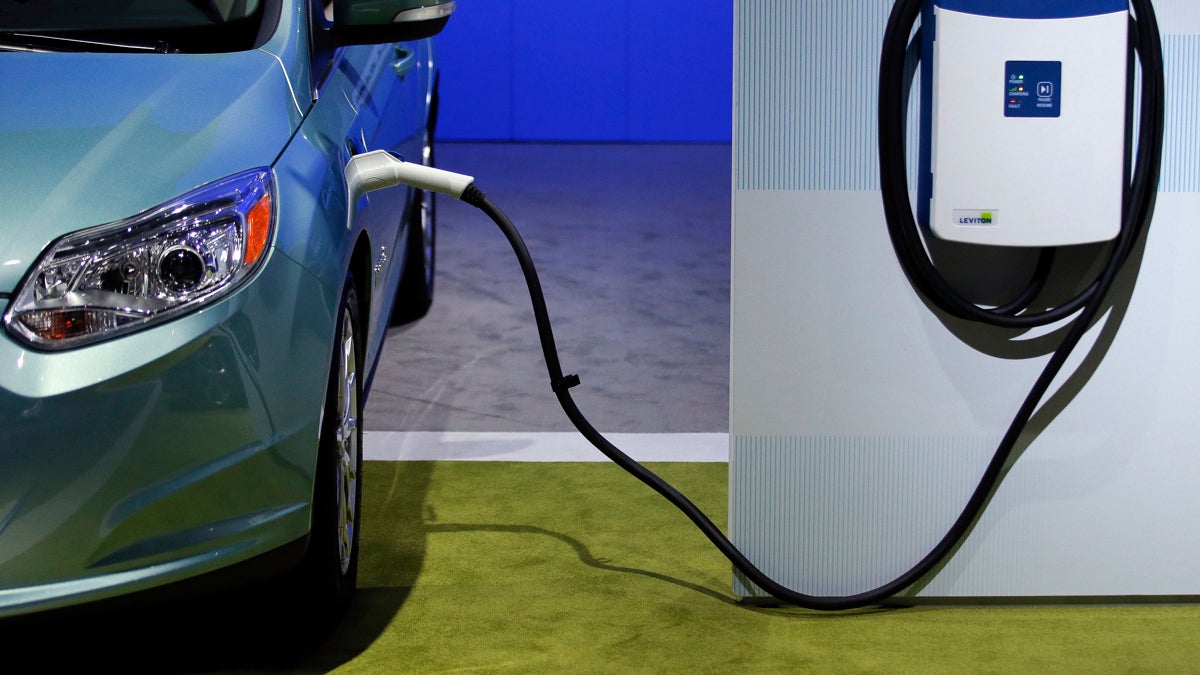Build it and they will come? For electric-car charging stations, maybe not yet
Listen
A charging station is displayed at the LA Auto Show in Los Angeles. (Jae C. Hong/Associated Press)
They’re quiet, they’re green (or greener, anyway, depending on the power plant) and they’ll get you a rebate — but still, electric cars remain very niche.
In his 2011 State of the Union Address, President Obama set a goal for one million electric cars on the road by 2015. But as of May 2014, that number sits at just 210,000, a mere sliver of the millions of cars and trucks sold in the U.S. every year.
So, how do innovations like the electric car take hold? Especially when charging-station infrastructure is a key part of the equation.
“Caring about the environment and caring about the future for my children and my grandchildren has always been a priority,” said Lori Braunstein, from behind the wheel of her black Chevy Volt. “So I was willing to sort of take the risk that I wouldn’t always be able to charge my car wherever I go.”
Taking a ride
On a recent Wednesday morning I hitched a ride with Braunstein on the final leg of her commute from Cherry Hill, N.J., to 24th and Walnut, in Philadelphia.
Her Volt was fresh off an overnight charge and was moving smoothly through Center City traffic.
“I love it,” she said. “I get very excited when I look down at my dashboard and I see all green. That makes me very happy.”
Braunstein is talking about the display on her plug-in hybrid that’s kind of like a video game for energy-efficient driving. If you do it right, you can use up the car’s electric miles before the gas engine kicks in.
Braunstein has had her Volt for about nine months now and she’s enthusiastic about its green street cred.
She admits, though, that electric ‘range anxiety,’ the fear of being stranded without a charge, pushed her in the direction of the gas-electric Volt. But her concerns there may be less of a problem soon, since her office building is planning on adding a charging station by the fall.
Pushing green into the parking lot … to mixed results
“So this is the parking lot at 2401 Walnut,” said Chuck Block, president of the Bedrock Group, which owns and manages the building near the banks of the Schuylkill.
The sleekly-renovated former railroad storage depot is looking to reach LEED Platinum certification — and is also becoming a hub for buzzy Philly startups.
To Block, having a charging station is a way of extending the building’s green footprint into the parking lot.
“The writing is on the wall,” Block said. “In the future there will be a whole lot more people driving electric cars and I think it’s an important amenity for a building.”
That’s still a future-tense proposition, Block admits, though Braunstein is at least one guaranteed customer.
Other outfits in Philly have had difficulty in finding those.
“It’s going OK,” said Parkway Corporation Chief Operating Officer Paul Ierubino. “We tried to get ahead of it. It’s the chicken-and-the-egg sort of thing.”
The parking lot operator has taken an early lead in installing chargers on its lots, using environmental incentives to add machines to about a fifth of its 60 locations in the Philly region.
And although the free-to-use chargers are seeing more usage year-over-year, Ierubino says the numbers are small. Parkway’s charger fleet saw roughly 1,000 charges last year, fewer than three a day. Ierubino is disappointed.
“We haven’t added any more since our two initial grants that we got — one from the state, one from the federal government — because there hasn’t been any real demand for it,” he said.
Chicken or the egg?
Some experts say the issue of finding a charge is only partly to blame for the slow adoption of the electric car.
Matthew Stepp heads up the Washington, D.C.-based Center for Clean Energy Innovation, which has studied the issue. Stepp says the No. 1 problem is that the batteries on which electric cars rely are still too expensive, which drives up the overall sticker price.
“People aren’t necessarily going to buy an electric vehicle because their business offers them a charging station; they’re going to buy an electric vehicle when it’s affordable and it makes sense for them,” Stepp said.
At the low end, the Nissan Leaf retails for about $30,000 while a Tesla Model S will cost you about $70,000. The Chevy Volt costs about $35,000, before rebates.
Leading the charge
Back at her office, Lori Braunstein is powering down her Volt. She says electric cars are becoming not just for environmentalists like her anymore.
If electric vehicles are to become as ubiquitous as Braunstein hopes, though, she believes consumers will have to lead the charge. The infrastructure will follow.
“If people see my car and I let my neighbors drive it and things like that, and people feel more comfortable with it, hopefully it will be something that becomes more commonplace in the region,” Braunstein said.
Maybe then, the chicken-or-the-egg problem of cars vs. chargers will finally be in the rear-view, despite some data suggesting a long road ahead.
In Pennsylvania, for instance, only 1,199 electric vehicle rebates have been issued since September 2011, according to a spokeswoman from the state’s Department of Environmental Protection, which administers the rebate program.
WHYY is your source for fact-based, in-depth journalism and information. As a nonprofit organization, we rely on financial support from readers like you. Please give today.



